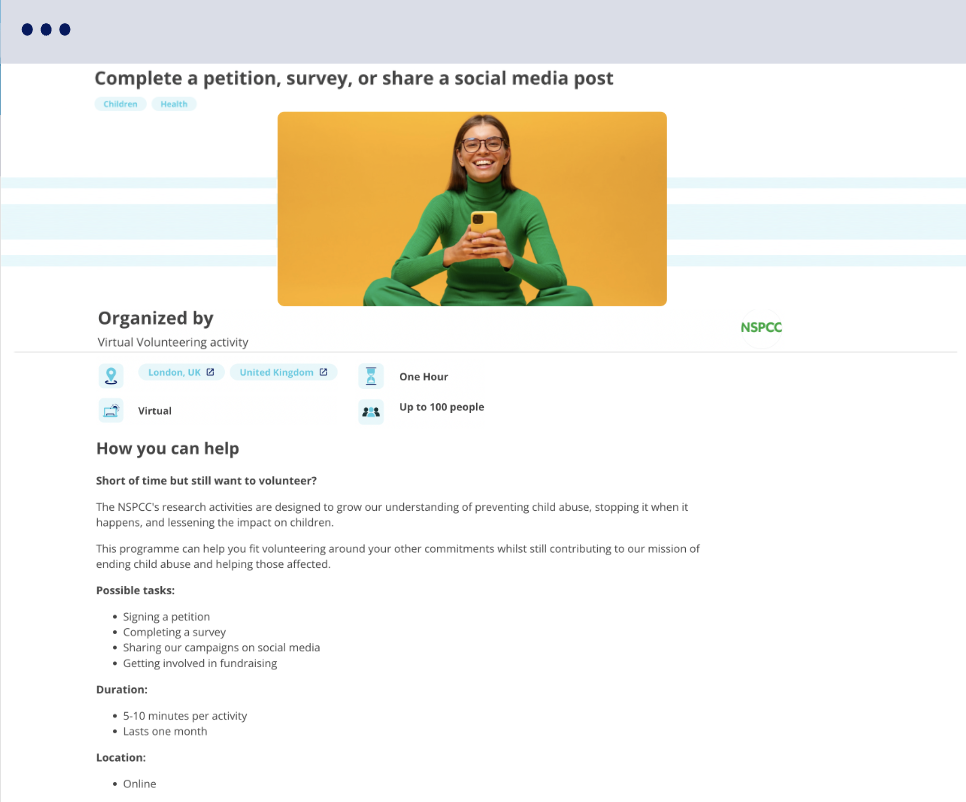Unlike traditional volunteering which often requires a significant time commitment or that it is conducted in person, micro-volunteering enables individuals to make a positive impact in a shorter amount of time, from anywhere in the world.
What exactly is micro-volunteering? Micro-volunteering entails task-based activities that require minimal time commitment. As a nonprofit, your organization can profit tremendously from micro-volunteering, as it allows you to gain long-term support from small actions.
In this article, we'll shed light on the essence of micro-volunteering and delve into the myriad of ways your organization can profit from its impact. From extending your reach and engagement to optimizing costs, we'll explore why micro-volunteering has become an essential strategy for nonprofits in today's fast-paced world. Moreover, we'll provide you with actionable insights on how to start creating your own micro-volunteering activities, ensuring your organization thrives in this era of purpose-driven impact.
Examples of micro-volunteering

Micro-volunteering is as diverse as the causes it supports. These bite-sized acts of kindness can range from quick tasks that take mere minutes to slightly more involved activities, all tailored to meet the specific needs of your nonprofit and the level of impact you wish to achieve..
Micro-volunteering activities conducted in less than 10 minutes
When individuals are short on time but still eager to make a difference, micro-volunteering offers a wealth of opportunities to contribute meaningfully, even in less than 10 minutes. Here are a few examples of activities that showcase the breadth of possibilities:
- Signing a petition: micro-volunteers can support causes or advocacy campaigns by signing online petitions. This can help nonprofits gather signatures to raise awareness, influence decision-makers, or drive legislative action.
- Liking or sharing a social media post: each click of the "like" button or the act of hitting "share" sets off a ripple effect, extending the reach of your nonprofit's message to a broader audience. The more engagement a post receives, the greater its visibility becomes, opening doors to new supporters, donors, and champions for your cause.
- Picking up trash: by dedicating a few moments to pick up trash whenever and wherever they see it, micro-volunteers can contribute to a cleaner and more environmentally friendly world.
- Filling out a survey: surveys serve as invaluable tools that inform decision-making, drive program development, and fuel advocacy initiatives, ultimately shaping a brighter future for those in need.
- Telling a friend: sharing your nonprofit’s mission multiplies the reach of your message. By notifying them of the impact and importance of the cause, individuals encourage others to get involved, volunteer, or support financially, amplifying your organization's ability to create positive change.
In this fast-paced world, it's easy to underestimate the potential of a few fleeting minutes. However, these small actions showcase the power to leave a profound and lasting impact on your organization.
Micro-volunteering activities conducted in more than 10 minutes
Naturally, micro-volunteering isn't only limited to quick tasks. In fact, there are numerous opportunities that allow volunteers to dedicate slightly more time and create a profound impact, whilst still remaining in the bracket of micro-volunteering. Below are examples of activities that take more than 10 minutes to complete, yet no more than 30 minutes.
- Goods donations: micro-volunteers can drop off clothing or non-perishable food items, supporting those in need with essential resources.
- Handing out flyers: individuals can help raise awareness about events, campaigns, or resources by distributing flyers and information in the community.
- Letter writing: participants can engage in meaningful letter or email exchanges with seniors, children, or individuals in hospitals, offering companionship, emotional support, and heartfelt friendship.
- Mentoring: micro-volunteers can share their expertise and guidance through career advice, skill-sharing, job searching, or personal development, empowering others on their journey to success.
- Skills-based volunteering: nonprofits can receive pro-bono support for tasks such as translating a flyer, writing a quick Instagram post, or utilizing any unique skills to aid your organization in its mission.
The beauty of micro-volunteering lies in its flexibility. As a nonprofit, you can tailor these activities to align with your organization's needs and the time availability of your volunteers. Whether it's a quick task that can be completed during a coffee break or a slightly more involved project, every minute counts when making a positive impact.
6 benefits of micro-volunteering for nonprofits

Let's explore the key benefits that micro-volunteering brings to both nonprofits and volunteers. These advantages highlight the power of small actions in creating meaningful and long-term impact. Through these small actions, volunteers become catalysts for change, spreading the word and amplifying your organization's message.
1. Reach volunteers remotely
One of the key benefits of micro-volunteering is its remote accessibility. With many micro-volunteering activities available virtually, individuals are no longer restricted by location, making it an inclusive and flexible option for those unable to commit to volunteering in person.
This remote accessibility opens doors for a diverse range of volunteers, from busy professionals with limited free time to individuals living in different time zones. Thanks to micro-volunteering, more individuals can now engage in meaningful contributions without physical constraints.
2. Operate around a flexible schedule
Micro-volunteering tasks are designed to fit within short timeframes and do not require a significant commitment. This flexibility allows individuals with busy schedules to engage and contribute their skills effectively. With micro-volunteering, making a difference becomes achievable, even when you have limited availability.
3. Reduce costs for your nonprofit
Opting for micro-volunteering brings financial advantages to your nonprofit. Rather than the expense of a single person providing a service, consider dividing tasks into mini-tasks, and have multiple people contribute with less time commitment and effort. This cost-effective approach of working with volunteers allows you to allocate resources more efficiently and focus on what truly matters – driving your organization's mission forward.
4. Access to more volunteers

Micro-volunteering acts as a gateway to attracting a broader audience of potential volunteers. It appeals to individuals who may not have considered long-term commitments, providing them with a low-barrier entry point to get involved. This diverse pool of volunteers brings new perspectives, fresh ideas, and a wide range of talents to your nonprofit, enriching your projects and initiatives in unique ways.
5. Create long-term impact
Micro-volunteering can ultimately lead to more than just a one-time engagement, as it acts as a stepping stone for volunteers to develop a deeper connection with your nonprofit. Volunteers who begin with short-term contributions often find themselves inspired to commit more time and effort to your cause. By cultivating these long-term relationships, you can create a loyal and dedicated support base, ensuring sustainability and growth for your nonprofit.
6. Available for all nonprofits
Micro-volunteering is a great way to get support for your nonprofit, regardless of how big or small your organization is. Smaller organizations can benefit from micro-volunteering by utilizing the skills and support of individuals who may not have the capacity for long-term commitments.
Likewise, larger organizations can leverage micro-volunteering to tap into a broader pool of volunteers and distribute tasks more efficiently.
How to identify micro-volunteering opportunities

It's essential to identify the right opportunities that align with your organization's mission and engage volunteers effectively. These strategies will help you identify micro-volunteering opportunities at your organization, enabling your nonprofit to make a meaningful impact:
● Identify your specific needs - begin by pinpointing tasks or projects that can be broken down into smaller, manageable micro-volunteering activities. Assess areas where micro-volunteers can make a meaningful impact, considering your organization's ongoing projects, goals, and challenges.
● Define clear objectives - define the expected outcomes of your micro-volunteering projects. Ensure that these objectives align with your nonprofit's overall mission and vision, and communicate them effectively to potential volunteers. Clear objectives help volunteers understand the purpose of their contributions and the impact they can make.
● Provide flexibility - ensure that micro-volunteering projects are flexible and convenient for volunteers. Design tasks that can be completed in less than 30 minutes and do not require a significant commitment. Provide options for remote or virtual participation to make it accessible to a broader range of volunteers.
● Offer clear instructions and resources - support volunteers by providing clear instructions and comprehensive guidelines for each micro-volunteering activity. Outline the expected deliverables, provide relevant resources or reference materials, and offer support or guidance when needed. Clear instructions will help volunteers understand the task at hand and feel confident in their ability to contribute effectively.
By following the steps above, you can create a thriving micro-volunteering culture in your nonprofit, allowing volunteers to make a meaningful impact while embracing flexibility and convenience.
How to get started with micro-volunteering

Doing good can happen anywhere and from anywhere. Benevity is a corporate purpose platform that brings nonprofits and companies together to create positive change through giving and donating. For nonprofits seeking support, our process is straightforward - just let us know how you need support. Once we have your details, we'll publish your volunteer opportunities, making them visible to our expansive network of corporate users.
Getting started with micro-volunteering on Benevity is a simple process. Just fill out this form with your organization’s details and how you need support, and you'll be on your way to publishing bite-sized volunteering opportunities that can create meaningful and lasting change.

Here is an example of a micro-volunteering activity on the Benevity platform, published by UK charity, the NSPCC. With a powerful call to action, "Short of time but still want to volunteer?", the NSPCC addresses the challenge faced by many individuals with busy schedules who are eager to volunteer but cannot commit to a significant time investment.This micro-volunteering opportunity offers a solution for those who want to make a meaningful impact, even in the midst of their packed schedules. Benevity empowers nonprofits and volunteers alike, bridging the gap between passion and limited availability. You can also submit other activities to connect with our corporate users. We offer:
- In-person volunteering - engage with a vibrant pool of in-person volunteers, ready to provide hands-on support for your initiatives, from cleanups and meal preparation to farm work.
- Skills-based volunteering - access a network of skilled professionals offering pro-bono expertise in fields such as translation, marketing, and web design.
- Goods collections - receive items such as IT equipment, canned food, and clothing.
- Virtual volunteering - connect with talented individuals who can contribute their skills remotely, further expanding your reach and impact.









